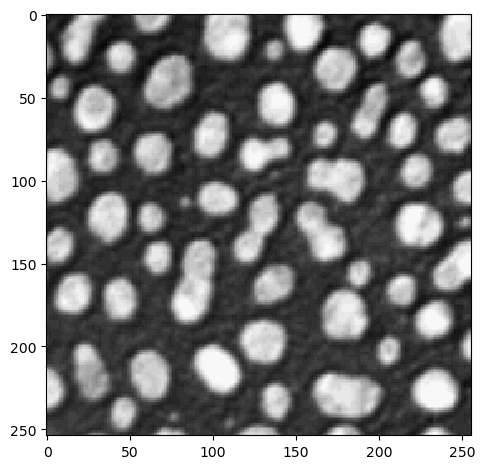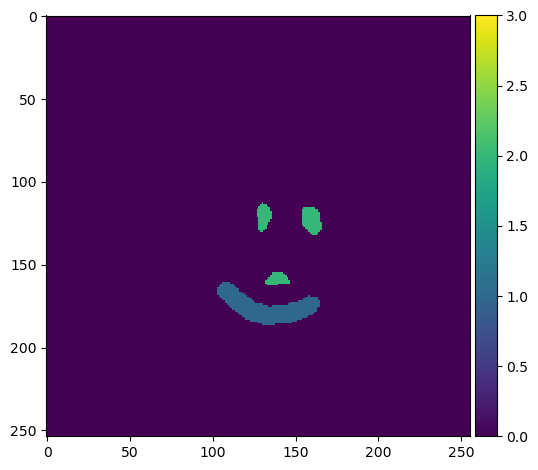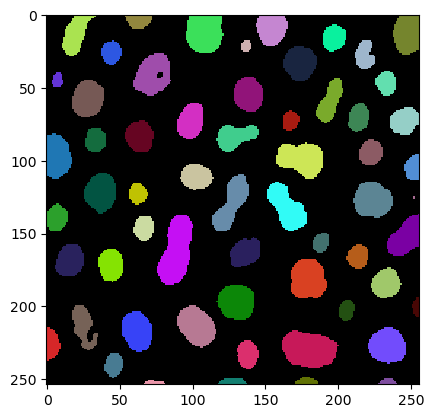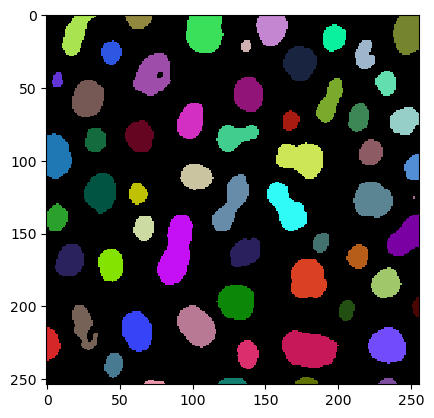Object segmentation on OpenCL-compatible GPUs
Contents
Object segmentation on OpenCL-compatible GPUs#
APOC is based on pyclesperanto and scikit-learn. For object segmentation, it uses a pixel classifier and connected components labeling.
from skimage.io import imread, imshow, imsave
import pyclesperanto_prototype as cle
import numpy as np
import apoc
from skimage.io import imshow
Let’s start with loading an example image and some sparse annotation:
image = imread('../../data/blobs.tif')
imshow(image)
<matplotlib.image.AxesImage at 0x1b3235a9820>

if False: # you can use this to make manual annotations
import napari
# start napari
viewer = napari.Viewer()
napari.run()
# add image
viewer.add_image(image)
# add an empty labels layer and keep it in a variable
labels = np.zeros(image.shape).astype(int)
manual_annotations.add_labels(labels)
else:
manual_annotations = imread('../../data/blobs_apoc_annotations.tif')
imshow(manual_annotations, vmin=0, vmax=3)
C:\Users\haase\mambaforge\envs\devbio-napari-env\lib\site-packages\skimage\io\_plugins\matplotlib_plugin.py:150: UserWarning: Low image data range; displaying image with stretched contrast.
lo, hi, cmap = _get_display_range(image)
<matplotlib.image.AxesImage at 0x1b3247cf580>

Training#
We now train a ObjectSegmenter, which is under the hood a scikit-learn RandomForestClassifier. After training, the classifier will be converted to clij-compatible OpenCL code and save to disk under a given filename.
# define features
features = 'gaussian_blur=1 sobel_of_gaussian_blur=1'
# this is where the model will be saved
cl_filename = 'my_model.cl'
apoc.erase_classifier(cl_filename)
clf = apoc.ObjectSegmenter(opencl_filename=cl_filename, positive_class_identifier=2)
clf.train(features, manual_annotations, image)
Prediction / segmentation#
The classifier can then be used to classify all pixels in the given image. Starting point is again, the feature stack. Thus, the user must make sure that the same features are used for training and for prediction. Prediction can be done on the CPU using the original scikit-learn code and on the GPU using the generated OpenCL-code. OCLRFC works well if both result images look identical.
segmentation_result = clf.predict(features=features, image=image)
cle.imshow(segmentation_result, labels=True)

Segmentation from a loaded segmenter#
clf = apoc.ObjectSegmenter(opencl_filename=cl_filename)
segmentation_result = clf.predict(image=image)
cle.imshow(segmentation_result, labels=True)

After training, we can also explore a bit how important the specified features were when making the pixel classification.
clf.feature_importances()
{'gaussian_blur=1': 0.7699547389372277,
'sobel_of_gaussian_blur=1': 0.23004526106277245}
Exercise#
Also include the original image in the features specified above and train the model again. How does feature importance change. Why?

